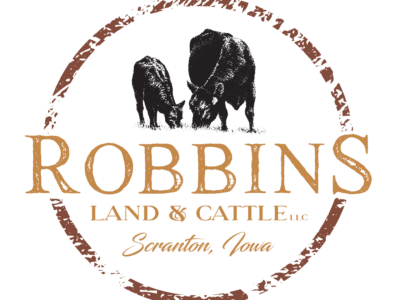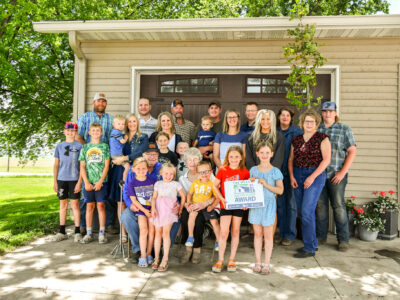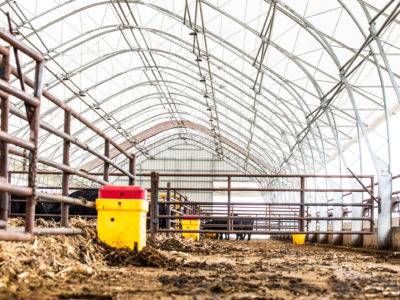Calving Under Roof Event Highlights Key Management Considerations for Cow-Calf Producers
04-06-2017 in Cattle
Shrinking pasture availability has led many cow-calf producers across the Midwest to consider calving under roof as a viable alternative. That’s why experts at the Coalition to Support Iowa’s Farmers recent Midwest Cow-Calf Symposium were invited to address the key management decisions of raising cows and calves in a confined setting.
Nearly 300 beginning and experienced farmers from eight states attended the two-day symposium in Omaha to learn about cow-calf health, nutrition and other best management practices.
According to Dr. Sara Barber, Veterinary Medical Center, raising cows and calves under roof presents a unique opportunity to manage pairs individually. However, additional management practices are required to maintain animal health.
 “Health is a balance in these barns,” Dr. Barber explained. “We have to control the environment and we have to do the best we can with the immunity of the calves.”
“Health is a balance in these barns,” Dr. Barber explained. “We have to control the environment and we have to do the best we can with the immunity of the calves.”
Controlling the under roof environment starts with proper bedding management. Dr. Barber says pens should always be kept dry and that bedding can easily be evaluated with what she calls the “dry knee test”.
“Fall on your knees and if your knees get wet when you get up, you know you need more bedding,” Dr. Barber said.
In terms of calf immunity, Dr. Barber stresses the importance of newborn calves taking advantage of their mother’s colostrum, a calf’s first and only available source of antibodies. She also recommends dipping calf navels with iodine to prevent infections, using designated supplies for sick calves and healthy calves and avoiding nose-to-nose contact with cattle brought to the farm from a different source.
Cow-calf producers like Chad and Amy Wilkerson of Linden, Iowa, agree that prevention is key when using the calving under roof approach. The Wilkerson’s fielded questions at the symposium as two of the eleven producer panelists. They currently raise 160 cow-calf pairs in a hoop barn they filled for the first time in January of 2016.
“It’s important to have a good nutritionist and a good vet,” Chad said. “You’ve got to have those two people in your back pocket that you know are going to be there and understand what you’re up against.”
Most Bang for the Bunk
Another consideration for cow-calf producers raising cow-calf pairs under roof includes adopting a nutrition program. According to Kelly Jones, co-manager of Cactus Feeders’ cow-calf division, feed is a major cost in this production system and requires rations that can be modified to coincide with the reproductive stage of the herd.
“Limit feeding allows us to individually cover the nutritional needs of dry cows, lactating cows or replacement heifers,” Jones explained. “But you can also tear down the condition of the herd pretty quick if you aren’t mindful of factors such as bunk space.”
Jones suggests an error on too much bunk space is far better than an error on too little, and that creep feeding areas featuring lowered bunks should be installed before calving begins. Other barn modifications may include incorporating maternity areas, working facilities and raising dirt levels around water tanks for calves.
Experts and cow-calf producers alike concluded that while there are many advantages to calving under roof, this system requires an intensive management system that may not be the right fit for every livestock farm. The Coalition to Support Iowa’s Farmers works beside Iowa farm families as they make important management decisions about growing the farm using new livestock technology such as calving under roof.
The Midwest Cow-Calf Symposium was co-sponsored by the Alliance for the Future of Agriculture in Nebraksa (AFAN), Iowa Cattlemen’s Association and the Nebraska Cattlemen. For more information from the event and virtual tours featuring Accu-Steel, Hoop Beef System and Central Confinement Service hoop barns, visit www.supportfarmers.com/cowcalfsymposium.
The Coalition to Support Iowa’s Farmers was created by farmers to help farmers raise livestock successfully and responsibly. It’s a joint partnership involving the Iowa Cattlemen’s Association, Iowa Corn Growers Association, Iowa Farm Bureau Federation, Iowa Pork Producers Association, Iowa Poultry Association, Iowa Soybean Association, Iowa Turkey Federation and Midwest Dairy Association.
The non-profit, non-partisan organization provides assistance to farmers at no cost. CSIF does not lobby or develop policy. Farm families wanting a helping hand can contact the Coalition at 1-800-932-2436 or visit www.supportfarmers.com.
-30-
Recommended News

Robbins Family Hosts Cattle Building Open House
Farmers interested in learning about the benefits of raising cattle under roof are invited to attend an open house at the Robbins family farm to tour Justin and Lacie Robbins...
Read More
Farming is a Family Affair
The Streit family of West Bend, Iowa, has cultivated their farm for over three decades, fostering a legacy of hard work and community support. Diane and Tony Streit, alongside their...
Read More
CSIF to Host Calving Under Roof Open House
WEST DES MOINES, IOWA – June 10, 2022 – The Coalition to Support Iowa’s Farmers (CSIF) is hosting a “Calving Under Roof Open House” at the Laura and Aaron Cunningham farm...
Read More